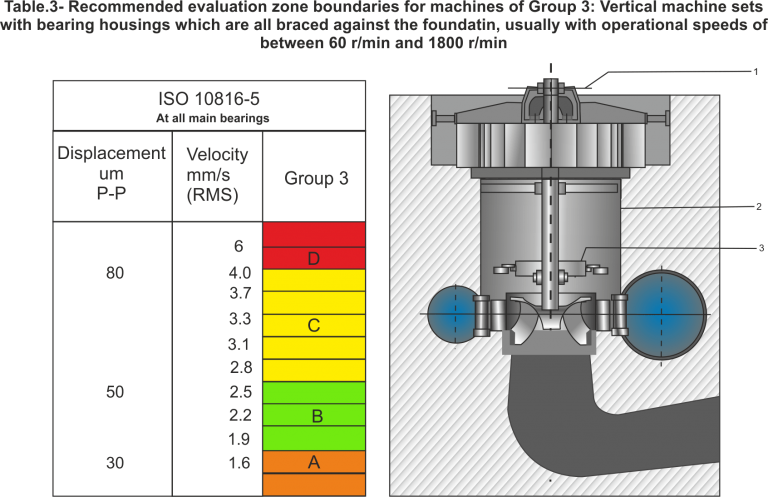ISO10816 Charts
Why ISO 10816 is important for vibration measurement engineers?
ISO 10816-1

General Machines
ISO10816-2

Steam Turbine and Generators
generators over 50 MW & rotational speeds from 1500 to 3600 RPM
ISO10816-3

Critical Machines
by accelerometer or velocity transducers on fixed parts like bearing housings
ISO10816-4

Gas Turbines
NOT: These Values, Which are the upper limits of zone A,B and C Respectively, Should apply to radial vibration measurements on all bearing housings or pedestals and to axial vibration measurements on housings containing an axial thrust bearing, under steady-state operating conditions at rated speed.in this figure shows typical measurement positions.
ISO10816-5



Hydro Turbine
ISO10816-6

Reciprocating Machinery
ISO 10816-6 specifies the general conditions and procedures for the measurement and evaluation of vibration, using measurements made on the non-rotating and non-reciprocating parts of reciprocating machines. It generally applies to reciprocating piston machines mounted either rigidly or resiliently with power ratings of above 100 kW. Typical examples of application are: marine propulsion engines, marine auxiliary engines, engines operating in diesel generator sets, gas compressors and engines for diesel locomotives. The general evaluation criteria which are presented relate to both operational monitoring and acceptance testing. They are also used to ensure that the machine vibration does not adversely affect the equipment directly mounted on the machine.
ISO10816-7

Pump
ISO 10816-7 gives instructions for the evaluation of vibration on rotary pumps for industrial applications with nominal power above 1 kW. It defines the special requirements for evaluation of vibration when the vibration measurements are made on non-rotating parts (bearing housing vibration). It provides specific guidance for assessing the severity of vibration measured on bearing housings of rotary pumps in situ and for the acceptance test at the manufacturer’s test facility or in the plant.
This part of ISO 10816 also gives general information and guidelines for assessing relative shaft vibration of the rotating shaft.
This part of ISO 10816 specifies zones and limits for the vibration of horizontal and vertical pumps irrespective of their support flexibility. Additionally, recommendations are given for defining operational limits and setting alarm and trip values.
ISO10816-8

Reciprocating Compressors
-
horizontal, vertical, V-, W-, and L-type compressor systems,
-
constant and variable speed compressors,
-
compressors driven by electric motors, gas, and diesel engines, steam turbines, with or without a gearbox, flexible or rigid coupling, and
-
dry running and lubricated reciprocating compressors.




ISO10816-21

